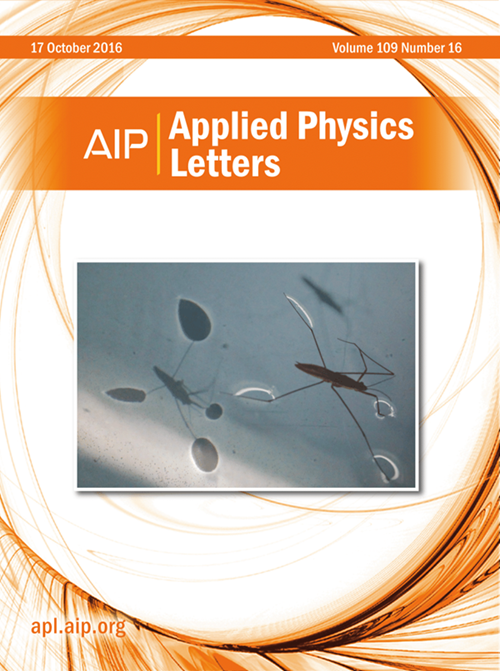A TEM study of MOCVD-grown rutile GeO2 films
IF 3.5
2区 物理与天体物理
Q2 PHYSICS, APPLIED
引用次数: 0
Abstract
Ultrawide bandgap semiconductors are promising for the next-generation power electronics, largely attributed to their substantial bandgap and exceptional breakdown electric field. Rutile GeO2 (r-GeO2) emerges as a promising alternative, particularly because of its ambipolar dopability. However, research on r-GeO2 is still in its infancy, and further investigation into its structural properties is essential for enhancing epilayer quality. In our previous work, we identified distinct surface morphologies—square-patterned and smooth regions—of r-GeO2 films grown on r-TiO2 (001) substrates using metal-organic chemical vapor deposition. This research employs transmission electron microscopy to investigate the structural characteristics of the material. The findings indicate that the square-patterned regions are crystalline, whereas the smooth regions exhibit amorphous properties. The measured lattice spacing in the (110) plane is 0.324 nm, slightly exceeding the theoretical value of 0.312 nm. This discrepancy suggests the presence of tensile strain in the r-GeO2 film, resulting from lattice mismatch or thermal expansion differences with the substrate. We also observed a threading dislocation density of 1.83 × 109 cm−2, consisting of 11.76% screw-type, 29.41% edge-type, 55.89% mixed-type dislocations, and 2.94% planar defects. These findings offer valuable insight into the growth mechanisms and defect characteristics of r-GeO2.mocvd生长金红石型GeO2薄膜的透射电镜研究
超宽带隙半导体在下一代电力电子领域具有广阔的应用前景,这主要归功于其巨大的带隙和特殊的击穿电场。金红石GeO2 (r-GeO2)是一种很有前途的替代品,特别是因为它的双极性可溶性。然而,对r-GeO2的研究仍处于起步阶段,进一步研究其结构性质对提高脱毛质量至关重要。在我们之前的工作中,我们使用金属有机化学气相沉积技术在r-TiO2(001)衬底上生长r-GeO2薄膜,发现了不同的表面形态——方形图案和光滑区域。本研究采用透射电子显微镜研究材料的结构特征。结果表明,方形图案区域是结晶的,而光滑区域则表现出非晶态的特性。(110)平面的晶格间距为0.324 nm,略高于理论值0.312 nm。这种差异表明r-GeO2薄膜中存在拉伸应变,这是由于晶格不匹配或与衬底的热膨胀差异造成的。我们还观察到螺纹位错密度为1.83 × 109 cm−2,其中螺旋型位错占11.76%,边缘型位错占29.41%,混合型位错占55.89%,平面型位错占2.94%。这些发现对r-GeO2的生长机制和缺陷特征提供了有价值的见解。
本文章由计算机程序翻译,如有差异,请以英文原文为准。
求助全文
约1分钟内获得全文
求助全文
来源期刊

Applied Physics Letters
物理-物理:应用
CiteScore
6.40
自引率
10.00%
发文量
1821
审稿时长
1.6 months
期刊介绍:
Applied Physics Letters (APL) features concise, up-to-date reports on significant new findings in applied physics. Emphasizing rapid dissemination of key data and new physical insights, APL offers prompt publication of new experimental and theoretical papers reporting applications of physics phenomena to all branches of science, engineering, and modern technology.
In addition to regular articles, the journal also publishes invited Fast Track, Perspectives, and in-depth Editorials which report on cutting-edge areas in applied physics.
APL Perspectives are forward-looking invited letters which highlight recent developments or discoveries. Emphasis is placed on very recent developments, potentially disruptive technologies, open questions and possible solutions. They also include a mini-roadmap detailing where the community should direct efforts in order for the phenomena to be viable for application and the challenges associated with meeting that performance threshold. Perspectives are characterized by personal viewpoints and opinions of recognized experts in the field.
Fast Track articles are invited original research articles that report results that are particularly novel and important or provide a significant advancement in an emerging field. Because of the urgency and scientific importance of the work, the peer review process is accelerated. If, during the review process, it becomes apparent that the paper does not meet the Fast Track criterion, it is returned to a normal track.
 求助内容:
求助内容: 应助结果提醒方式:
应助结果提醒方式:


